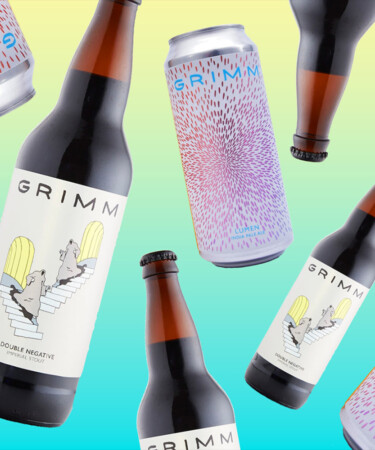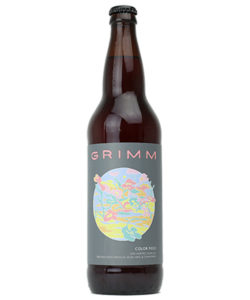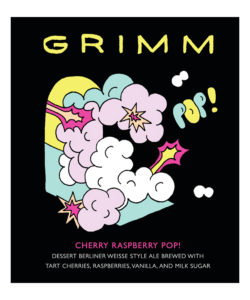If you ask any beer nerd to name their five favorite New York City breweries, you can bet your bottom dollar that Grimm Artisanal Ales will make the cut. Not to do a disservice to other local breweries, but the proof is in the pudding. And by pudding, we mean Untappd.com.
From their world-class hazies like Lumen to decadent pastry stouts like the Babka series, Grimm shows prowess in almost every beer style. But its real bread and butter is spontaneously fermented mixed culture beers: For years, the Grimm team has been fueled by curiosity, experimenting with yeast strains, local fruits, herbs, botanicals, and unconventional brewing techniques.
Grimm’s Williamsburg brick and mortar is now a triple threat, serving up house-made pizza, beer, and wine. And these days, Grimm beer can be found in most major cities from coast to coast. But of course, that wasn’t always the case.
We sat down with co-founders Lauren and Joe Grimm to talk about their journey from brewing in their apartment kitchen to owning a brewery, winery, and pizza restaurant in the heart of Brooklyn. Here are eight things you should know about Grimm Artisanal Ales.
-
Lauren and Joe Grimm attended art school before getting into beer.
Well before their passion for all things fermented blossomed, the Grimms were renting art studio space in Providence, R.I. Lauren was a sculptor and Joe was building interactive art installations involving film projectors and synthesizers. Then, one of them picked up a copy of Sandor Katz’s “Wild Fermentation” book, and they began fermenting everything they could — both food and beverage — eventually narrowing down to just beer.
Joe and Lauren relocated to Chicago in 2007 to attend graduate school, and they started setting up beer stands at their friends’ performances and gallery openings, slowly accumulating a following among their peers. After earning their degrees, the couple moved to Brooklyn and worked a myriad of odd jobs to pay the rent. That’s when the idea to start a licensed brewery to make and sell their beer began to crystallize. What originally was supposed to be a means to fund their art and passion projects quickly grew and took over the majority of the couple’s time.
From the get-go, Grimm’s signature can and bottle art has stood out on the beer shelf, characterized by pop art sleekness and playful, child-like illustrations (that still avoid looking like a kid actually drew them).
“When we first began, Lauren was doing a lot of the label design along with our friend Gretta Johnson, but as we got more and more busy, we needed help,” Joe says. So they brought on Johnson to handle most of the artwork, making her the first official employee at Grimm Artisanal Ales. Lauren, though, still does create some of the can art: Grimm’s Lambo Door series, Tesseract IPA, or Wavetable IPA all boast her designs.
-
Lauren and Joe ran a beer C.S.A. before they started a brewery.
C.S.A. (community-supported agriculture) programs are normally confined to the conventions of a weekly basket of roma tomatoes, celery, and the occasional obscure squash. But the Grimms saw new potential for the subscription model while living in Chicago, back when the couple was homebrewing at a prolific rate.
“Our homebrewing habit was getting out of control. We couldn’t justify continuing to brew more recipes because the house was just full of bottles of beer,” Joe explains. To allow them to both brew more and clear up the clutter, Joe and Lauren thought of starting a weekly local beer C.S.A. program. They sent out emails to everyone they knew, proposed a rate, and dropped beer off at their friends’ doorsteps every week, making it possible for Lauren and Joe to learn more and brew every few days.
-
Grimm started as a nomadic brewery, swearing to only brew Belgian styles.
By the time the Grimms moved to NYC and became a licensed brewery, the artists didn’t have the means to open their own space. So, they had to brew at other breweries.
“For the first five years, we basically booked time at other breweries whenever they had empty tanks,” Joe says. “There were three different breweries we worked with a lot. We sourced our own ingredients and traveled up and down the Eastern Seaboard.” In 2013, Grimm Artisanal Ales released its first beer: a Belgian blonde with rose hips called From the Hip.
The brewery’s original goal was to make only Belgian-style beers, but as Lauren says, “that quickly changed.” While Grimm remains a heavily fermentation-focused project, sanitation was a major issue when borrowing brew space considering all the wild yeasts and bacteria involved in making such beers. “One of the big motivations to open our own space was that we wanted a robust spontaneous fermentation program, and we knew that wasn’t going to happen in someone else’s facility,” Lauren explains. By being a nomadic brewery, the Grimms accumulated tax credit to take out a loan, and then began building their own site. And in 2018, they opened for business.
-
Grimm just opened a pizzeria.
“I’ve been cooking since I was a child,” Lauren says. Her sister went to culinary school, and Joe fell in love with New Haven-style pizza while studying at Yale University. When Lauren and Joe met, they bonded over their passion for food and cooking. Brewing beer took center stage in both of their lives, but Lauren had always thought it would be fun to make and serve food for their brewery guests. In July 2023, they acted on their pizza pipe dream and opened Lala’s Brooklyn Apizza on the brewery’s rooftop. Using malted grain from their beer, mixed culture from their sour ales, a little help from chef and pizzaiolo Esther Stilwell, the Grimm team crafted a number of New Haven-inspired pizza recipes.
“We’re calling it Brooklyn apizza, pronounced ah-beets,” Joe says, as the style is known as apizza in New Haven. While not quintessential New Haven apizza, Lala’s take holds true to its roots by using pecorino and olive oil on every pie, and topping them with unconventional add-ons like mashed potatoes.
-
Grimm also makes wine now.
In late 2022, Grimm launched Physica Wines, an experimental sister winery that sources all of its grapes from the North Fork of Long Island. “It really began when we started this series of beers called ‘Gathering,’ which is all about using whole local fruits from New York and New Jersey,” Joe explains. Because the brewery planned to use fruit that wasn’t blended into a purée or processed in any way, the team needed to figure out how to get these fruits into the beer. They started researching wine techniques, and decided to pursue carbonic maceration to ferment a number of fruits like blackberries, blueberries, and cherries.
At first, Lauren and Joe were planning to release their wines under the “Grimm” label, but Joe thought the wines deserved their own name. “We had to reprint the labels the first time because they said Grimm on them,” Lauren says. Thus, Physica Wines was born, and the same brewers who make Grimm beer are in charge of wine production.
“When I look at where the New York State wine community is right now, it reminds me of where beer was when we started,” Lauren explains.
-
The brewery strives for sustainability.
There’s an astonishing amount of ingredient crossover between the brewery, winery, and pizzeria at the Grimm empire. In addition to sharing malted grain and yeast between the beer and pizza production, the way that the brewery uses its produce yields minimal waste. With the use of carbonic maceration, whole fruits go into the fermentation tanks — leaves and stems included. Plus, nothing is crushed. About a month into the maceration process, brewers take all of the free-run juice and use it to make Physica wines.
“Ordinarily, it would be a pretty inefficient way of making wine,” Joe explains. However, the grapes have a second life after all of the free-run juice is collected. Grimm’s brewers take a blend of their barrel-aged sour beers and rack them into the fermentation tank to steep in the macerated grapes and ultimately create a new product.
The brewery also recently acquired new equipment that allows it to recapture any CO2 emissions that result from brewing. Once the “CC” machine collects CO2, it cleans the gas up until it’s almost free of any other compounds, making it even more pure than commercially available CO2. The brewing team can then use the CO2 to carbonate Grimm beer and fuel a number of other processes in the day-to-day functions of the brewery. “It all helps us to be more self-reliant,” Joe says.
-
Grimm recently coined the term ‘Crispy IPA.’
Cold IPAs are all the rage these days. The style, characterized by low fermentation temperatures and the use of lager yeast, is beloved for its hoppy profile and crisp texture while still packing the ABV punch of a conventional IPA. But the Grimms saw room for improvement, specifically in terms of the style’s ABV.
“We wanted to make an IPA that drank more like a lawn mower beer,” Joe says. As a response to the cold IPA trend, Grimm Artisanal Ales brewed up a Crispy IPA. The team took an American light lager yeast strain, brewed a lager, and hopped it to high heaven. The result: an extremely crushable but hop-forward lager that tastes like an ultra-crisp session IPA. “It’s like a hoppy Budweiser,” Joe explains. Crackle, Grimm’s 4.5 percent ABV Crispy IPA, is hopped with Citra, Strata, and Columbus.
-
Simcoe the cat is the official Grimm mascot.
There are bodega cats, and then there are brewery cats. The Grimms adopted Simcoe — named after the hop varietal — in 2018. Her age is undetermined, but she’s still spearheading all pest control situations at the brewery. Any mice that dare enter Grimm’s facility have to get past Simcoe first. She can be found on any given day lounging around outside the brewery or among the foeders and fermentation tanks.


